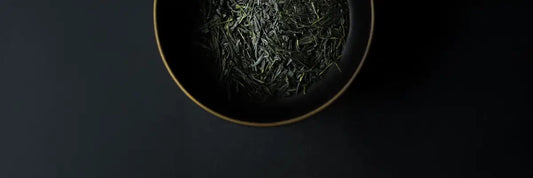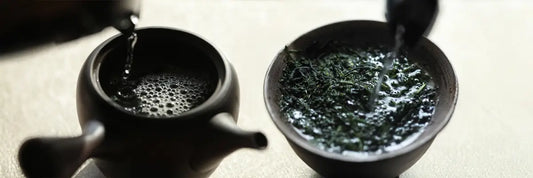Gyokuro vs tencha is a comparison that is often made, but there are actually a few key differences between these teas.
Gyokuro is a tea you all might be familiar with if you follow our videos and blog articles, but tencha might be a new one for you.
These leaves are not typically drunk as a tea, but they are ground up into a powder to make matcha tea.
As it is not intended to be drunk on its own, there are many differences between tencha vs gyokuro.
In this article, we're going to learn the difference between gyokuro and tencha and teach you how each tea is made and what it’s used for.
Let's get started! 👇🍃
What Are Gyokuro and Tencha?
Before comparing gyokuro vs tencha, it’s important to understand what each tea actually is.
While they come from the same shaded tea plants, their purpose and preparation are quite different.

What is Gyokuro?
Gyokuro is Japan’s most luxurious shaded green tea, harvested from the youngest sprouts and shaded for over 3 weeks.
Known for its deep umami, natural sweetness, and rich body, gyokuro is brewed as a loose-leaf tea and enjoyed for its layered flavor profile.
Its needle-shaped leaves and savory taste make it one of the most celebrated Japanese teas.

What is Tencha?
Tencha, on the other hand, is rarely consumed as a loose-leaf tea.
After being shaded and steamed like gyokuro, its stems are removed and the leaves are dried flat instead of rolled.
This makes them perfect for grinding into the fine powder we know as matcha.
While tencha on its own is mild and incomplete in flavor, it is the essential base material for producing ceremonial matcha.
The production
Tencha, gyokuro, matcha and kabusecha are all made from shaded tea plants. Gyokuro plants and tencha plants need to be shaded for the longest time, 3 weeks or more before the harvest.
When the tea plant is exposed to sunlight, it begins to convert theanine into catechins in order to protect itself against UV light. This may be good for the tea plant, but the catechins are what give tea its bitter flavor.
If a farmer wants to produce a smoother and sweeter tea like kabuse sencha, gyokuro or matcha, they will cover the tea plant. This reduces the amount of catechins and maximizes the sweet and savory theanine. This is a similarity between tencha vs gyokuro.

Shading of tencha leaves vs gyokuro
Another similarity between gyokuro vs tencha is that they are made using the youngest sprouts on the tea plant.
Gyokuro is made from the first 3 sprouts and tencha can be made from the first 5 sprouts.
These sprouts are the sweetest and most flavorful, which is why they are used for premium Japanese green teas like gyokuro, tencha and kabusecha.
Because tencha is made from an additional 2 leaves, there is a slight difference in the tencha leaves vs gyokuro.
Leaves need to be unoxidized
After the leaves are harvested, they are quickly moved to the processing facility to be turned into the various tea types. As soon as the leaves are picked, they will begin to oxidize naturally and eventually the tea will turn into a black tea.
In order to be considered a green tea, the leaves need to be unoxidized. To deactivate the enzymes that cause oxidation, you need to apply heat to the leaves. For Japanese green teas, the leaves are taken through a steam bath, which locks in the green colors and flavors of the tea leaves. This process will be carried out for both tencha and gyokuro, but what happens next leads to the differences in tencha vs gyokuro.
The difference between tencha vs gyokuro
Tencha has its stems removed after it is harvested
Unlike gyokuro, tencha actually has its stems removed after it is harvested. This is an important step in order to prepare it for grinding. This is a key difference between gyokuro and tencha, and tencha is really the only type of tea that goes through this stem removal process.
The stems will not grind as easily and they don’t have quite as sweet of a flavor compared to the leaves. Another thing you will notice when you look at the stems within the leaf: they are much yellower than the leaf itself. This means that the final color of the matcha won't be as green if the stems are not removed.
To remove the stems requires 2 different steps
- First, the stems need to be separated and then they need to be sorted. While these processes can vary, it is common to use a machine that rubs the leaves over a flat surface in order to separate them from the leaf.
- Once the leaves and stems have been separated, the leaves are put into a series of tall nets and air is blown underneath them. The leaves are much lighter and tend to float higher so they will reach the top of the net and make it into the next stage. The heavier stems will be stuck at the bottom and not able to move on to the next stage. The stems will not be wasted; they can be used to make stem teas or included in lower quality teas like teabags.
Tencha vs gyokuro leaves
If you compare tencha leaves vs gyokuro leaves, you will notice the difference between the two right away.
Because tencha goes through the additional stem removal process, the leaves are all broken up into these small flat pieces.

Flavor profiles
Gyokuro, on the other hand, goes through 2 separate rolling phases, giving the tea its trademark pine needle shape.
By rolling the leaves, you crush the outer membrane of the leaf, priming it for extraction in the teapot, and then tightly curl the leaves to lock in the flavor until it's infused.
Because tencha is just going to be ground into matcha, it doesn’t go through this rolling phase and therefore it’s not as flavorful when you brew the tea. This is what creates the difference between the leaves of gyokuro vs tencha.
Did you know that some people are even eating gyokuro leaves? To learn more about it, read our article 👉 Why people are Eating Gyokuro Leaves?
Final thoughts
When it comes to gyokuro vs tencha, it seems that there are more similarities than there are differences. Both teas are shaded for 3 weeks before the harvest, they are made from the top leaves of the tea plant and they are steamed after harvest.
The only difference between tencha vs gyokuro is that tencha leaves need to have their stems removed so that they can be ground into matcha.
If you're interested to learn more about the difference of gyokuro vs matcha, we recommend the article 👉 Tea Comparison between Gyokuro vs Matcha.
Where to try these teas
The best way to enjoy tencha is to simply enjoy matcha. This is the finished product and, if it is mixed into water properly, it can create a delicious and unique drinking experience.
A good ceremonial matcha for beginners is the Noike Matcha. This is a super smooth Okumidori matcha and it’s made by the talented farmer Mr. Noike just outside of Kyoto.
A final difference between tencha vs gyokuro is that gyokuro is meant to be consumed as is, and we're going to show you how to do just that in the next section!

Where to buy gyokuro
Now that you know all the differences between gyokuro vs tencha, you are ready to prepare your own!
Where to buy gyokuro green tea is a question we often get asked, and the answer is a bit complicated.
We wrote an entire article in which we will teach you everything you need to know before you buy gyokuro, how to buy gyokuro green tea and where to buy gyokuro.
If you want to read it, here is the link for the article 👉 Where to buy gyokuro green tea.
Nio Teas & Mr. Sakamoto
 If you are interested in trying gyokuro tea, you can try the excellent gyokuro from Mr. Sakamoto in Shibushi.
If you are interested in trying gyokuro tea, you can try the excellent gyokuro from Mr. Sakamoto in Shibushi.
Mr. Sakamoto has been growing gyokuro without the use of pesticides or chemicals since 1985, and during that time he has developed his own blend of organic fertilizer.
With this fertilizer, he is able to grow strong, healthy and flavorful plants without harming the natural ecosystem.
A good gyokuro to start with is the Cha Musume, a sweet, savory and floral gyokuro from the Yabukita cultivar.





1 comment
It’s a pity you don’t have a donate button! I’d definitely donate to this excellent blog! I guess for now i’ll settle for bookmarking and adding your RSS feed to my Google account. I look forward to new updates and will share this website with my Facebook group. Chat soon!